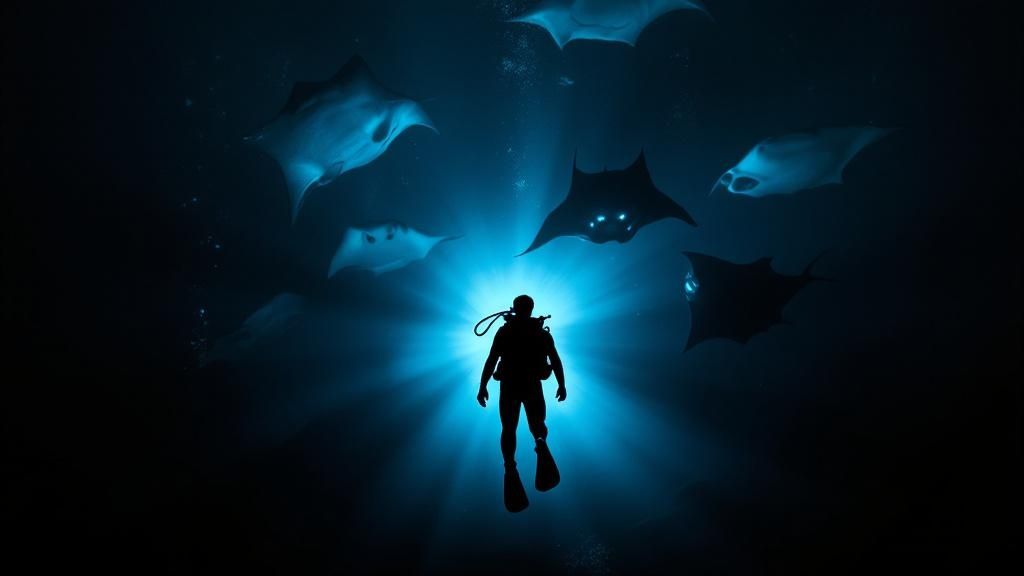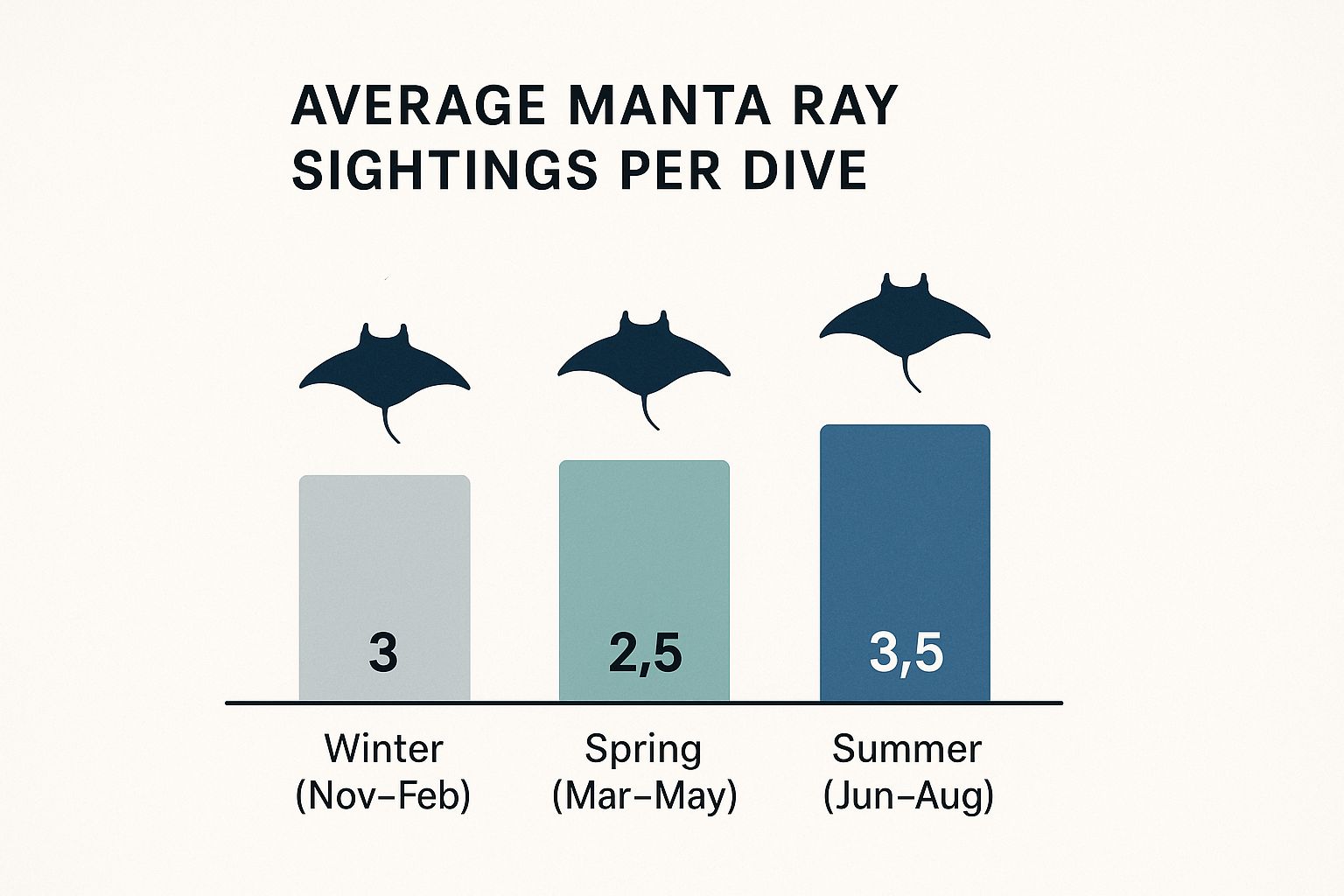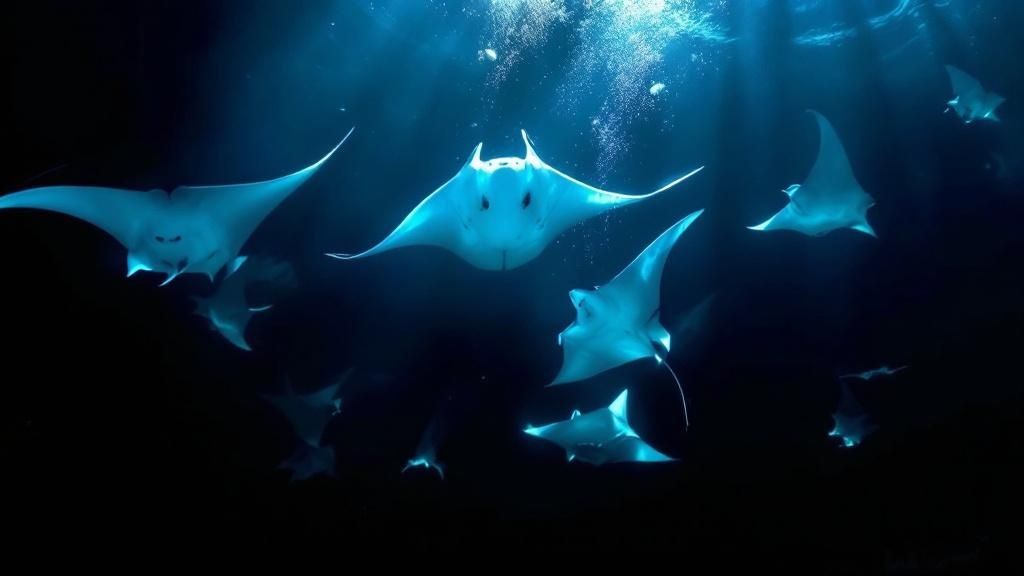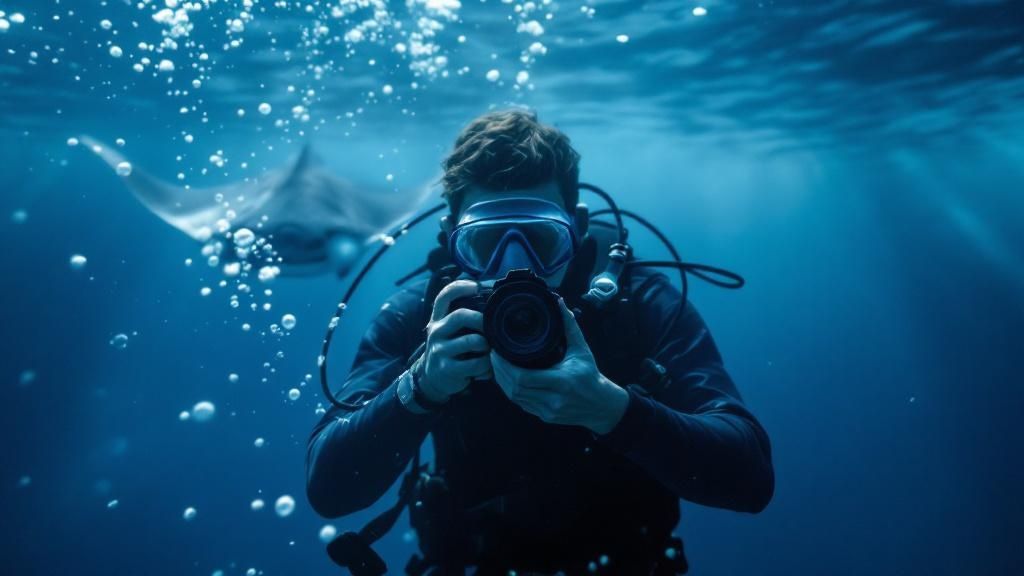Why Kona Is The World's Premier Manta Ray Destination
Kailua Kona consistently earns its reputation as the manta ray capital of the world. This isn't just a catchy slogan; it's a result of the unique combination of elements that create a sanctuary for these gentle giants. The secret lies in the perfect blend of geography, ocean currents, and a flourishing ecosystem.
The Perfect Recipe for Manta Ray Encounters
The volcanic slopes of the Big Island create a distinct underwater landscape. This, combined with the nutrient-rich currents of the Pacific, cultivates an incredibly abundant plankton population. These microscopic organisms are the primary food source for manta rays, attracting them to Kona's waters. The consistently warm water temperatures further provide an ideal habitat for both the plankton and the mantas.
Predictability Sets Kona Apart
What truly separates Kona from other manta ray locations is the remarkable predictability of sightings. Unlike other areas where encounters are infrequent, Kona boasts a high success rate. Manta ray night dives in Kailua Kona have an impressive success rate, typically ranging between 80% and 90% year-round. This popularity is highlighted by the significant number of visitors, with approximately 80,000 people joining manta ray snorkeling and diving excursions annually. Find more detailed statistics here This consistency stems from the dependable presence of plankton in specific areas, creating predictable feeding zones for the mantas every night. You might also be interested in: What it's like to go on a Manta Ray dive in Kona.

A Living Laboratory for Manta Ray Research
This predictability has also established Kona as a living laboratory for manta ray research. Scientists and researchers have carefully recorded the behaviors, feeding habits, and individual traits of these magnificent creatures. This ongoing research not only expands our knowledge of manta rays but also supports effective conservation initiatives, ensuring these incredible manta ray night dive experiences remain for future generations.
Your Complete Guide To Kona's Top Manta Ray Dive Sites
Not all dive sites are created equal when it comes to the magic of manta rays. Knowing the right location dramatically impacts your manta ray night dive in Kailua Kona. Let's explore the best spots for consistent manta ray encounters, including the famous Garden Eel Cove and Manta Village.
Understanding Kona's Unique Dive Site Advantages
Each dive site has unique characteristics that influence manta ray activity. Depth and currents are crucial in creating the perfect environment for these graceful creatures. Some sites attract specific manta ray populations, increasing the diversity of your potential sightings. Understanding these nuances helps you choose the best site for your diving level and desired experience.
Manta Heaven (Garden Eel Cove) vs. Manta Village
Garden Eel Cove, north of Kailua Kona, is often preferred for its sheltered environment and higher manta ray concentration. Manta Village, south of Kona near Keauhou Bay, is known for its consistently high manta ray sighting success rate. The success of these dives is directly related to the strategic choice of these locations, which provide excellent conditions for manta ray encounters. Learn more about manta ray dive sites and their success rates.
Accessibility, crowd levels, and optimal viewing conditions also affect your experience. Some sites are easier to reach, while certain times of year might be more crowded. Considering these practicalities enhances your dive enjoyment.
To help you compare the key dive sites, we've compiled the following table:
To help you compare, here's a breakdown of the main Kona manta ray dive sites:
Kona Manta Ray Dive Sites Comparison
| Site Name | Location | Success Rate | Best For | Key Features |
|---|---|---|---|---|
| Garden Eel Cove (Manta Heaven) | North of Kailua Kona | High | Experienced Divers | Protected environment, higher manta concentration |
| Manta Village | South of Kona, near Keauhou Bay | Consistently High | All skill levels | Easy access, calm conditions |
| Other Kona Coast Sites | Various | Varies | Varies | May offer unique experiences |
As the table shows, both Garden Eel Cove and Manta Village offer high success rates, but cater to slightly different preferences. Garden Eel Cove may appeal to more experienced divers, while Manta Village provides a user-friendly experience for all levels. Don't overlook other Kona Coast sites, which can offer unique dive experiences.
Seasonal Manta Ray Sightings in Kona

This infographic shows average manta ray sightings per dive across three seasons. Manta ray sightings remain consistent throughout the year, with a slight summer increase (June-August) averaging 3.5 sightings per dive. Winter (November-February) and spring (March-May) offer slightly fewer sightings, averaging 3 and 2.5 respectively, but encounter opportunities remain high. This consistent activity makes Kailua Kona a prime manta ray night dive destination year-round. You might be interested in: What is a manta ray night dive?.
Understanding these strategic advantages, including seasonal and weather impacts on site selection, helps you maximize your manta ray night dive experience. You'll know not just where to dive, but why certain sites consistently deliver extraordinary manta ray encounters.
Meet The Magnificent Manta Rays Of Kona Waters
These aren't just large fish; they're intelligent, graceful creatures with distinct personalities. Prepare to be mesmerized during your manta ray night dive in Kailua Kona. Let's explore what makes Kona's manta rays so unique.
Giants of the Deep: Size and Grace
Manta rays have impressive wingspans reaching up to 20 feet. Picture a creature as wide as a school bus gliding effortlessly through the water. Their swimming patterns are surprisingly graceful, resembling underwater flight. This elegance contrasts with their immense size, creating a truly awe-inspiring sight. You might be interested in: The Top Manta Ray Experience Near Waikoloa Village, HI.
The Mesmerizing Manta Ballet: Feeding Displays
During night dives, you'll witness the captivating feeding displays of these gentle giants. They perform a mesmerizing ballet, swooping and swirling through the illuminated waters with their mouths open wide, filtering plankton. It's a spectacle that will leave you breathless. The sheer size of the manta rays adds to the experience. On average, the mantas in Kona measure about 12 feet in length, making them a breathtaking sight. Explore this topic further
Intelligence and Social Behavior: More Than Meets the Eye
Manta rays are incredibly intelligent. Studies suggest they can recognize individual divers and display complex social behaviors. This adds another layer of fascination to your encounter, transforming a simple observation into a connection with a sentient being. Their ability to learn and adapt highlights their crucial role in the delicate balance of the marine ecosystem.
Understanding the Gentle Giants: Migration and Feeding
Manta rays play a vital role in the marine ecosystem. Their migration patterns and feeding habits contribute to the overall health of the ocean. Learning about these factors deepens your understanding of these gentle giants. This knowledge transforms a simple underwater encounter into a profound connection with one of the ocean's most magnificent creatures. Learn more in our article about why you should go on a manta ray dive in Kona.
The Fascinating History Behind Kona's Manta Ray Fame
Every legendary diving destination has its origins, and Kona's journey to becoming synonymous with manta rays is particularly captivating. From chance encounters to the globally renowned experience it is today, the story weaves together human curiosity and the magic of these gentle giants.

From Accidental Encounters to Dedicated Research
Initially, manta ray sightings in Kona were serendipitous. Divers and snorkelers would catch glimpses of these majestic creatures during daytime excursions. A pivotal moment arrived with the observation that manta rays were attracted to the lights of coastal resorts. The plankton that gathered beneath these lights proved irresistible. This sparked a question: could artificial lights be used to create reliable manta ray viewing opportunities?
Pioneering the Manta Ray Night Dive
This question led dive operators and researchers to experiment with underwater lights. They discovered that these lights could consistently attract manta rays, allowing for close encounters. This innovation marked the birth of the manta ray night dive, a truly unique experience that propelled Kona onto the world diving stage. Between 2009 and 2014, a team of underwater videographers significantly advanced this new field. Filming six to seven nights a week at key locations like 'Manta Village' and 'Manta Heaven', they demonstrated the consistency of manta ray appearances and broadened our understanding of their behavior and habitat preferences. Discover more insights about manta ray statistics.
Refining Techniques and Ensuring Sustainability
Years of meticulous observation and documentation led to refined diving techniques. Optimal light placement, diver positioning, and responsible interaction practices were developed, improving sighting success rates and guest experience. Crucially, these pioneering efforts also established sustainable diving practices, emphasizing minimal environmental impact and respectful observation of the manta rays.
Conservation Efforts: Protecting Kona's Gentle Giants
The increasing popularity of manta ray night dives brought the importance of conservation to the forefront. Local initiatives and community involvement were essential in establishing protected areas and responsible diving guidelines. These combined efforts safeguard Kona's manta ray population, ensuring future generations can witness these magical encounters. This historical perspective highlights the crucial balance between tourism and conservation, demonstrating how responsible practices protect the very creatures that make the experience so extraordinary.
Choosing Your Perfect Manta Ray Dive Operator
Selecting the right manta ray dive operator in Kailua Kona is paramount to a truly unforgettable experience. This decision affects everything from your safety and comfort to the overall quality of your encounter with these magnificent creatures. Since not all operators are created equal, understanding what sets the exceptional apart from the rest is crucial.
Key Factors for Operator Selection
Choosing a dive operator requires careful consideration of several vital factors. These range from fundamental safety practices to the operator's dedication to preserving our oceans.
-
Safety Protocols: Prioritize operators with a demonstrable commitment to safety, featuring up-to-date equipment and certified dive masters.
-
Group Size: Smaller groups often translate to a more personalized and intimate experience, minimizing disruption to the manta rays' natural behavior.
-
Equipment Quality: Well-maintained equipment is essential for a safe and comfortable dive. Consult online reviews and inquire about the operator's equipment maintenance procedures.
-
Experience and Local Reputation: Opt for operators boasting extensive local expertise and positive testimonials. Their familiarity with the area enhances your dive and promotes responsible interactions with the manta rays.
Experience Levels and Dive Options
Your personal experience level should also inform your choice of dive. Some operators cater specifically to beginners, providing snorkeling excursions, while others specialize in more advanced diving adventures. Choosing an option that aligns with your skill level and comfort ensures a safe and enjoyable experience for everyone.
Asking the Right Questions
Never hesitate to ask potential operators detailed questions about their certifications, safety measures, group sizes, and experience. A reputable operator will gladly address your concerns and provide transparent responses. This open communication fosters trust and empowers you to make a well-informed decision. Read also: Why should you go on a manta ray dive in Kona?
Prioritizing Conservation
Selecting an operator committed to marine conservation ensures your adventure contributes to the long-term well-being of these incredible animals and their environment. Inquire about their involvement in conservation efforts and adherence to sustainable diving practices. Knowing you're supporting responsible tourism adds a deeper level of significance to your manta ray encounter.
To help you navigate the selection process, the following table summarizes key criteria to consider when choosing your dive operator:
Dive Operator Selection Criteria: Essential factors to consider when choosing a manta ray night dive operator in Kailua Kona
| Criteria | Why It Matters | What To Look For | Red Flags |
|---|---|---|---|
| Safety Protocols | Protects divers and ensures a safe experience. | Up-to-date certifications, well-maintained equipment, emergency plans. | Lack of certifications, outdated equipment, vague safety procedures. |
| Group Size | Impacts diver comfort and minimizes disturbance to manta rays. | Smaller groups (6-8 divers) are generally preferred. | Overcrowded dives (10+ divers). |
| Equipment Quality | Ensures a comfortable and safe dive. | Well-maintained gear, comfortable fit, appropriate for night diving. | Worn-out equipment, ill-fitting gear, lack of specialized night gear. |
| Experience/Local Reputation | Operators with local knowledge enhance the experience and ensure responsible interactions. | Positive reviews, established presence in the community, experienced guides. | Negative reviews, lack of local knowledge, inexperienced staff. |
| Conservation Practices | Supports the long-term protection of manta rays and their habitat. | Participation in conservation initiatives, sustainable diving practices. | Disregard for environmental impact, irresponsible interaction with mantas. |
The table above highlights the crucial factors to consider when evaluating potential dive operators. Prioritizing safety, responsible practices, and conservation ensures a rewarding and ethical experience.
By thoughtfully considering these elements, you can confidently choose a manta ray night dive operator in Kailua Kona that values both extraordinary experiences and environmental stewardship. This allows you to fully embrace the magic of this unique encounter.
Essential Preparation For Your Night Dive Adventure
A successful manta ray night dive in Kailua Kona starts with the right preparation. Planning ahead can transform an average dive into a truly unforgettable experience. This involves getting physically ready, familiarizing yourself with your equipment, and preparing mentally for this unique underwater adventure.
Physical and Mental Readiness
Being physically prepared ensures you'll fully enjoy your dive. Maintain good overall health and be comfortable in the water. While not excessively demanding, manta ray night dives require a basic level of fitness for comfortable finning and water entry. Mental preparation is just as vital. Familiarize yourself with standard night diving procedures and understand the dive plan. This will help manage any potential anxiety and allow you to fully appreciate the incredible experience that awaits.
Equipment Check: Your Underwater Essentials
Make sure your dive equipment is in top-notch condition. This includes a thorough check of your mask, fins, snorkel, and dive computer. A well-functioning dive light is absolutely essential for night dives, and a backup light is highly recommended. For daytime adventures, explore Kona's beautiful beaches with our guide on the 10 Best Beaches in Kona, Big Island, Hawaii. Knowing your gear, especially your dive light’s operation, will prevent fumbling in the dark and maximize your enjoyment.
Pre-Dive Briefing: Essential Information and Safety Protocols
Listen carefully to the pre-dive briefing. Your dive guide will cover key safety procedures specific to night diving and manta ray interaction. They’ll explain entry and exit techniques, underwater communication signals, and how to maintain proper buoyancy control to avoid disturbing the manta rays or the ocean floor. Positioning yourself for the best viewing while respecting the mantas’ natural behavior will also be discussed. This information guarantees a safe and respectful encounter for both you and these majestic creatures.

Responsible Interaction: Protecting the Mantas
Keep in mind that you are a guest in the manta rays’ natural environment. Responsible interaction is vital for their well-being and the future of these dives. Avoid touching the manta rays, as this can harm their protective mucus layer. Maintain a respectful distance and let the mantas come to you. Don’t chase or try to ride them. Following these guidelines helps protect the manta ray population and ensures this magical experience can be enjoyed for years to come. This responsible approach enhances your dive, transforming it from simple observation into a meaningful connection with these intelligent and graceful animals.
Maximizing Your Manta Ray Encounter Experience
You've traveled to Kailua Kona for a once-in-a-lifetime experience: a manta ray night dive. Let's ensure every moment counts. Beyond just showing up, here are proven strategies to elevate a good encounter into something truly unforgettable.
Optimal Positioning: Respectful Observation For the Best Views
Positioning yourself correctly is key to maximizing your manta ray viewing without disturbing these gentle giants. Divers should settle on the ocean floor and direct their dive lights upwards. This attracts plankton, which, in turn, draws the mantas closer. Snorkelers should hold onto the provided flotation devices (also equipped with lights) and remain on the surface to avoid interfering with the mantas' feeding patterns. Maintaining a respectful distance allows the mantas to approach you naturally, creating a more authentic and awe-inspiring experience.
Capturing the Magic: Underwater Photography Tips
Photographing these magnificent creatures requires specific techniques. Using a red filter on your underwater camera or strobe light helps neutralize the blue tones prevalent at depth, revealing the mantas' true colors. Adjusting your camera settings to a faster shutter speed helps capture their graceful movements without blur. Focus on composition, framing the mantas against the backdrop of the illuminated water for dramatic effect. These tips will help you capture stunning images of your manta ray night dive in Kailua Kona.
Decoding Manta Behavior: Understanding Their Signals
Learning to interpret manta ray behavior enhances your encounter. Barrel rolls, where the manta repeatedly somersaults, indicate enthusiastic feeding. Chain feeding, where multiple mantas follow each other in a line, signals a concentrated plankton source, offering spectacular viewing opportunities. Understanding these cues helps you anticipate the most dramatic displays and position yourself for the best possible views.
Extending the Experience: Pre and Post-Dive Rituals
Maximizing your manta ray night dive experience goes beyond the dive itself. Before your dive, connect with the ocean's energy through meditation or mindful breathing exercises. This can enhance your receptivity to the experience. Afterwards, reflect on your encounter through journaling or sharing stories with fellow divers. These practices solidify the memory and deepen the impact of this incredible encounter.
Seasonal Considerations and Other Big Island Adventures
While manta rays are present year-round in Kona, seasonal factors can influence your experience. Summer months often bring slightly higher numbers of manta rays. Combining your manta ray dive with other Big Island experiences, like visiting Volcanoes National Park or exploring Kona's coffee plantations, creates a truly unforgettable trip.
Supporting Conservation: Ensuring Future Encounters
Your visit can contribute to ongoing manta ray conservation efforts. Choose operators committed to sustainable practices, such as Kona Honu Divers, and avoid touching the mantas. Touching them can disrupt their delicate mucus layer. Supporting responsible tourism ensures these magical encounters remain available for generations to come.
